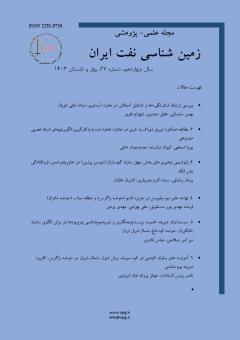بررسی ارتباط شکستگی¬ها و تشكيل آسفالتن در مخزن آسماری، ميدان نفتی كوپال
محورهای موضوعی : Petroleum Geologyبهمن سلیمانی 1 * , عقیل حیدری 2 , شهرام تقوی پور 3
1 - استاد دانشگاه شهید چمران اهواز
2 - کارشناس ارشد مناطق نفتخيز جنوب، اهواز، ايران
3 - مناطق نفتخیز جنوب
کلید واژه: نمودارهای تصویرگر, مخزن آسماری, میدان کوپال, سیستم شکستگی, آسفالتن,
چکیده مقاله :
مطالعه شکستگیها نقش مهمی در شناخت رفتار مخزن دارد و این نقش با فرایند رسوب اسفالتن می تواند کاهش یابد. این فرایند در بسیاری از میادین نفتی جهان و در بخشهای مختلف صنعت مشکلات بسیار جدی را بوجود آورده و فرایندی متداول محسوب می شود. مهمترین جنبه آن در مهاجرت سیالات نفتی مخزن است. در این مقاله سعی شده تأثیر شکستگی ها در پیدایش اسفالتن را در مخزن آسماری میدان نفتی کوپال با استفاده از نمودارهای تصویرگر OBMI-UBI مورد بررسی قرار گیرد. اكثر شكستگي ها با توجه به الگوي شكستگي هاي مرتبط با چين خوردگي از نوع درزهاي مورب و طولي اند. شكستگي ها در فواصل عمقی هیدروكربن دار نسبت به بقيه فواصل عمقی كمتر در نمودارهای تصویرگر آشكار شده است. لايه ماسه سنگي پاييني با بيشترين شكستگي و اكثرا از نوع باز مشخص مي شوند. عمده شكستگي هاي باز در نيمه پايينی آسماري شناسایی گردید كه متشكل از پلمه سنگ و ماسه سنگ است. بررسی چگالي شكستگي باز نشان مي دهد زون هاي 2 و 3 بيشترين و زون 4 كمترين تراكم شكستگي را دارا هستند. با توجه به راستای شکستگیهای ریزشی ناشی از حفاری، جهت حداكثر تنش افقي (δHmax)، N55E و جهت حداقل تنش افقي (δHmin) N35W است. این راستا با راستای عمومی زاگرس مطابقت دارد. داده های مربوط به هرز روی گل نشان داد که حداکثر مقدار با محل تمرکز شکستگی ها انطباق دارد. نتایج آنالیز نمونه های نفتی نشان داد که درصد اسفالتن در مخزن آسماری پایین بوده و در چاه های مختلف هیچ ارتباطی به فاصله زمانی تولید ندارد. درصد آسفالتن از 6/0 تا 75/2 درصد متغیر است. بطور کلی آسفالتن اولیه در نفت ها وجود ندارند. افزایش درصد شکستگیها در مخزن نسبت به عمق نیز با افزایش درصد اسفالتن تولید شده همراه است.
The study of fractures plays an important role in understanding the behavior of the reservoir, and this role can be reduced by the process of asphaltene deposition. Its most important aspect is in the migration of reservoir petroleum fluids. In this article, an attempt has been made to investigate the effect of fractures on the formation of asphaltene in the Asmari reservoir of Kopal oil field located in North Dezful embeyment by using different Image logs, OBMI-UBI. According to the pattern of fractures related to folding, most of the fractures are of the type of oblique and longitudinal seams. The lower sandstone layer is characterized by the most fractures and mostly of the open type. Most of the open fractures were identified in the lower half of Asmari (consists of mudstone and sandstone). The examination of open fracture density shows that zones 2 and 3 have the highest and zone 4 has the lowest fracture density. According to the direction of collapse fractures caused by drilling, the direction of maximum horizontal stress (δHmax) is N55E and the direction of minimum horizontal stress (δHmin) is N35W. This direction corresponds to the general direction of Zagros. The data on mud loss showed that the maximum value corresponds to the location of the concentration of fractures. The results of the analysis of oil samples showed that the percentage of asphaltene in the Asmari reservoir is low and has no relation to the production time in different wells. The percentage of asphaltene varies from 0.6 to 2.75%. In general, primary asphaltene does not exist in oils. The increase in the percentage of fractures in the reservoir compared to the depth is also associated with the increase in the percentage of asphaltene produced. Key words: Image logs, Asmari reservoir, Kupal oil field, Fracture system, Asphaltene

